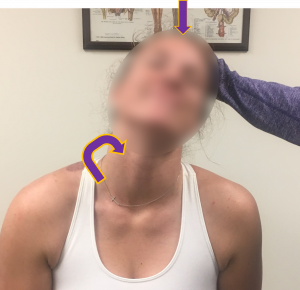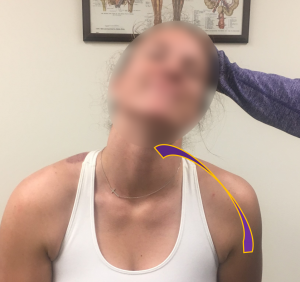Cervical spine
For a problem focused exam of a patient with neck pain, you should:
Inspect: from posteriorly, observing symmetry of shoulder height and musculature.
Palpate: the vertebrae and paraspinous muscles from the occipital protuberance to C7, observing for tenderness, spasm, and asymmetry:
Range of motion: Assess flexion, extension, lateral rotation, side bending
Neurovascular testing: To assess for compression of nerve roots or spinal cord, test
- Strength: Abduction of the shoulder, flexion and extension of the elbow, flexion and extension of the wrist, flexion, abduction and adduction of the fingers.
- Reflexes: Biceps, triceps, and brachioradialis
- Sensation: Key sensor points as described below
Stability and special tests as directed by the differential:
- If you suspect cervical radiculopathy, perform the Spurling test
Inspection & Palpation
Inspect the neck and shoulders posteriorly, observing for symmetry of shoulder height and musculature, especially the trapezius. Then, palpate from the occipital protuberance to C7, observing for pain or tenderness of the spinal column or paraspinous muscles.
Range of motion
Normal range of motion of the neck is:
- Flexion: 80 to 90 degrees
- Extension: 70 degrees
- Lateral rotation: 90 degrees
- Side bending: 20 to 40 degrees
Neurovascular testing
Cervical radiculopathy can affect one or more levels of the cervical spine, with characteristic patterns of weakness, numbness and reflex changes based on the levels that are affected. With the patient seated test:
- Strength: Abduction of the shoulder, flexion and extension of the elbow, flexion and extension of the wrist, flexion, abduction and adduction of the fingers.
- Reflexes: Biceps, triceps, and brachioradialis
- Sensation: Key sensor points below
Stability and special tests
If you are concerned about cervical radiculopathy, perform Spurling’s Test
– Neck is extended and laterally rotated slightly
– Axial load is then placed down on head by examiner
– Pain, numbness, tingling recreated in the upper extremity is considered a positive test and indicative of a radiculopathy
 |
 |

